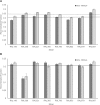Wolbachia Infection Associated with Increased Recombination in Drosophila
- PMID: 30459180
- PMCID: PMC6325905
- DOI: 10.1534/g3.118.200827
Wolbachia Infection Associated with Increased Recombination in Drosophila
Abstract
Wolbachia is a maternally-transmitted endosymbiotic bacteria that infects a large diversity of arthropod and nematode hosts. Some strains of Wolbachia are parasitic, manipulating host reproduction to benefit themselves, while other strains of Wolbachia exhibit obligate or facultative mutualisms with their host. The effects of Wolbachia on its host are many, though primarily relate to host immune and reproductive function. Here we test the hypothesis that Wolbachia infection alters the frequency of homologous recombination during meiosis. We use D. melanogaster as a model system, and survey recombination in eight wild-derived Wolbachia-infected (strain wMel) and Wolbachia-uninfected strains, controlling for genotype. We measure recombination in two intervals of the genome. Our results indicate that Wolbachia infection is associated with increased recombination in one genomic interval and not the other. The effect of Wolbachia infection on recombination is thus heterogenous across the genome. Our data also indicate a reproductive benefit of Wolbachia infection; infected females show higher fecundity than their uninfected genotypic controls. Given the prevalence of Wolbachia infection in natural populations, our findings suggest that Wolbachia infection is likely to contribute to recombination rate and fecundity variation among individuals in nature.
Keywords: Drosophila; Recombination; Wolbachia; phenotypic plasticity.
Copyright © 2019 by the Genetics Society of America.
Figures


Similar articles
-
Ovarian transcriptional response to Wolbachia infection in D. melanogaster in the context of between-genotype variation in gene expression.G3 (Bethesda). 2023 May 2;13(5):jkad047. doi: 10.1093/g3journal/jkad047. G3 (Bethesda). 2023. PMID: 36857313 Free PMC article.
-
Diversifying selection and host adaptation in two endosymbiont genomes.BMC Evol Biol. 2007 Apr 30;7:68. doi: 10.1186/1471-2148-7-68. BMC Evol Biol. 2007. PMID: 17470297 Free PMC article.
-
Paternal Grandmother Age Affects the Strength of Wolbachia-Induced Cytoplasmic Incompatibility in Drosophila melanogaster.mBio. 2019 Nov 5;10(6):e01879-19. doi: 10.1128/mBio.01879-19. mBio. 2019. PMID: 31690673 Free PMC article.
-
Wolbachia genomes: revealing the biology of parasitism and mutualism.Trends Parasitol. 2006 Feb;22(2):60-5. doi: 10.1016/j.pt.2005.12.012. Epub 2006 Jan 10. Trends Parasitol. 2006. PMID: 16406333 Review.
-
The Biochemistry of Cytoplasmic Incompatibility Caused by Endosymbiotic Bacteria.Genes (Basel). 2020 Jul 25;11(8):852. doi: 10.3390/genes11080852. Genes (Basel). 2020. PMID: 32722516 Free PMC article. Review.
Cited by
-
Deciphering the Impact of a Bacterial Infection on Meiotic Recombination in Arabidopsis with Fluorescence Tagged Lines.Genes (Basel). 2020 Jul 21;11(7):832. doi: 10.3390/genes11070832. Genes (Basel). 2020. PMID: 32708324 Free PMC article.
-
Pathogen infection alters the gene expression landscape of transposable elements in Drosophila melanogaster.G3 (Bethesda). 2024 Sep 4;14(9):jkae171. doi: 10.1093/g3journal/jkae171. G3 (Bethesda). 2024. PMID: 39129654 Free PMC article.
-
Wolbachia pipientis Associated With Tephritid Fruit Fly Pests: From Basic Research to Applications.Front Microbiol. 2020 Jun 3;11:1080. doi: 10.3389/fmicb.2020.01080. eCollection 2020. Front Microbiol. 2020. PMID: 32582067 Free PMC article. Review.
-
Transcriptomic characterization of Wolbachia endosymbiont from Leuronota fagarae (Hemiptera: Psylloidae).Microbiome Res Rep. 2025 Apr 3;4(2):19. doi: 10.20517/mrr.2024.84. eCollection 2025. Microbiome Res Rep. 2025. PMID: 40852124 Free PMC article.
-
Ovarian transcriptional response to Wolbachia infection in D. melanogaster in the context of between-genotype variation in gene expression.G3 (Bethesda). 2023 May 2;13(5):jkad047. doi: 10.1093/g3journal/jkad047. G3 (Bethesda). 2023. PMID: 36857313 Free PMC article.
References
Publication types
MeSH terms
LinkOut - more resources
Full Text Sources
Other Literature Sources
Molecular Biology Databases
